1988 PONTIAC FIERO oil change
[x] Cancel search: oil changePage 755 of 1825
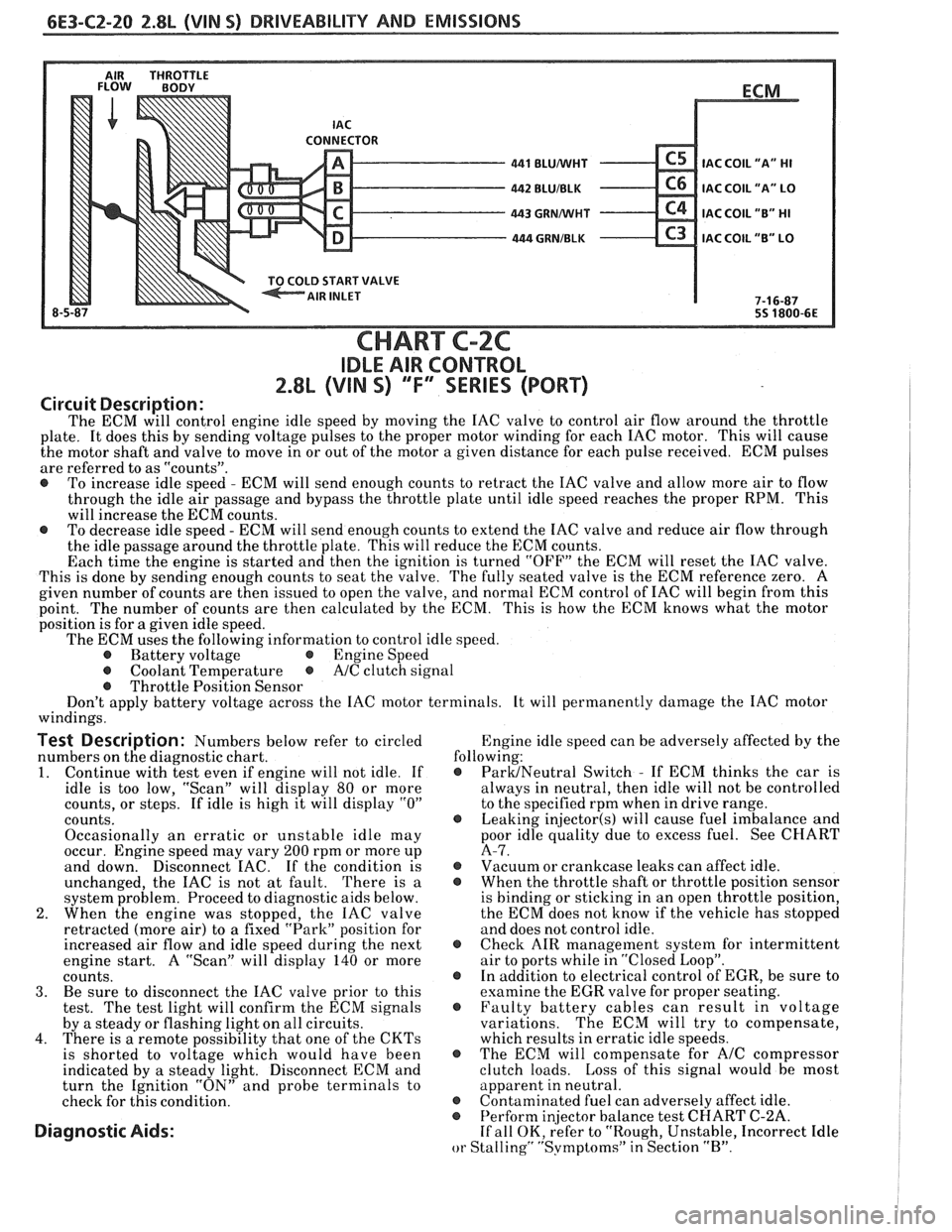
6E3-C2-20 2.8L (VIN S) DRIVEABILITY AND EMISSIONS
AIR THROTTLE FLOW BODY
LD START VALVE
8-5 BLUNVHT
BLUIBLK
GRMNVHT
. GRNIBLK
ECM
.
IAC COIL
"A" HI
IAC COIL "A" LO
IAC COIL "B" HI
C3 IAC COIL "B" LO
7-1 6-87
55 1800-6E
CHART C-2C
IDLE AIR CONTROL
2.8L (VIN S) ""F-SERIES (PORT)
Circuit Description:
The ECM will control engine idle speed by moving the IAC valve to control air flow around the throttle
plate. It does this by sending voltage pulses to the proper motor winding for each IAC motor. This will cause
the motor shaft and valve to move in or out of the motor a given distance for each pulse received. ECM pulses
are referred to as "counts".
@ To increase idle speed - ECM will send enough counts to retract the IAC valve and allow more air to flow
through the idle air passage and bypass the throttle plate until idle speed reaches the proper RPM. This
will increase the ECM counts.
@ To decrease idle speed - ECM will send enough counts to extend the IAC valve and reduce air flow through
the idle passage around the throttle plate. This will reduce the ECM counts.
Each time the engine is started and then the ignition is turned "OFF" the ECM will reset the IAC valve.
This is done by sending enough counts to seat the valve. The fully seated valve is the ECM reference zero. A
given number of counts are then issued to open the valve, and normal ECM control of IAC will begin from this
point. The
number of counts are then calculated by the ECM. This is how the ECM knows what the motor
position is for
a given idle speed.
The ECM uses the following information to control idle speed.
@ Battery voltage @ Engine Speed
@ Coolant Temperature @ A/C clutch signal
@ Throttle Position Sensor
Don't apply battery voltage across the IAC motor terminals. It will permanently damage the IAC motor
windings.
Test Description: Numbers below refer to circled Engine
idle speed can be adversely affected by the
numbers on the diagnostic chart. following:
1. Continue
with test even if engine will not idle. If @ ParUNeutral Switch - If ECM thinks the car is
idle is too low, "Scan" will display
80 or more always
in neutral, then idle will not be controlled
counts, or steps. If idle is high it will display
"0" to the specified rpm when in drive range.
counts.
@ Leaking injector(s) will cause fuel imbalance and
Occasionally an erratic or unstable idle may poor
idle quality due to excess fuel. See CHART
occur. Engine speed may vary
200 rpm or more up A-7.
and down. Disconnect
EAC. If the condition is @ Vacuum or crankcase leaks can affect idle.
unchanged, the IAC is not at fault. There is
a @ When the throttle shaft or throttle position sensor
system problem. Proceed to diagnostic aids below. is
binding or sticking in an open throttle position,
2. When the engine was stopped, the IAC valve the
ECM does not know if the vehicle has stopped
retracted (more air) to a fixed "Park" position for and does not control idle.
increased air flow and idle speed during the next
@ Check AIR management system for intermittent
engine start. A "Scan" will display
140 or more air
to ports while in "Closed Loop".
counts. @ In addition to electrical control of EGR, be sure to
3. Be sure to disconnect the IAC valve prior to this examine the
EGR valve for proper seating.
test. The test light will confirm the ECM signals @ Faulty battery cables can result in voltage
by a steady or flashing light on all circuits. variations. The
ECM will try to compensate,
4. There is a remote possibility that one of the CKTs which results in erratic idle speeds.
is shorted to voltage which would have been @ The ECM will compensate for A/C compressor
indicated by a steady light. Disconnect ECM and clutch
loads. Loss of this signal would be most
turn the Ignition "ON" and probe terminals to apparent
in neutral.
check for this condition.
@ Contaminated fuel can adversely affect idle. @ Perform in
or Stalling" "Svmptoms" in Section "B".
Page 845 of 1825
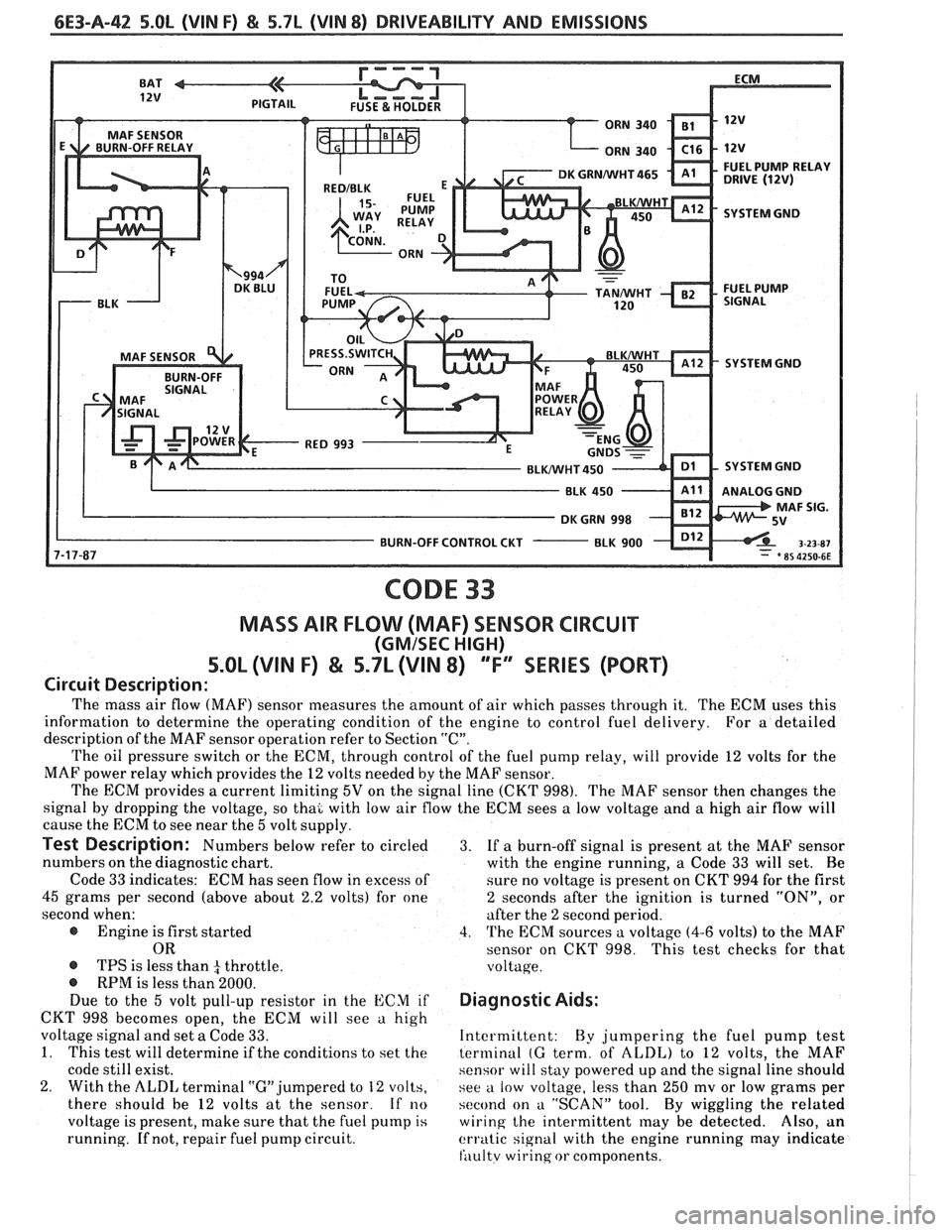
6E3-A-42 S.OL (VIN F) & 5.7L (VIN 8) DRIVEABILITY AND EMISSIONS
SYSTEM GND
SYSTEM GND
SYSTEM GND
ANALOG GND
BURN-OFF CONTROL CKT
-
CODE 33
MASS AIR FLOW (MAF) SENSOR CIRCUIT
(GMISEC HIGH)
5.OL (VIN F) & 5.7L (VIN 8) ""FY"IES (PORT)
Circuit Description:
The mass air flow (MAF) sensor measures the amount of air which passes through it. The ECM uses this
information to determine the operating condition of the engine to control fuel delivery.
For
a detailed
description of the MAF sensor operation refer to Section
"C".
The oil pressure switch or the ECM, through control of the fuel pump relay, will provide 12 volts for the
MAF power relay which provides the
12 volts needed by the MAF sensor.
The ECM provides
a current limiting 5V on the signal line (CKT 998). The MAF sensor then changes the
signal by dropping the voltage, so thai with low air flow the ECM sees
a low voltage and a high air flow will
cause the ECM to see near the
5 volt supply.
Test Description: Numbers below refer to circled 3. If a burn-off signal is present at the MAF sensor
numbers on the diagnostic chart.
with the engine running, a Code
33 will set. Be
Code
33 indicates: ECM has seen flow in excess of
sure no voltage is present on CKT 994 for the first
45 grams per second (above about 2.2 volts) for one 2 seconds after the ignition is turned "ON", or
second when: after the
2 second period.
@ Engine is first started 4. The ECM sources a voltage (4-6 volts) to the MAF
OR sensor on CKT 998. This test checks for that
@ TPS is less than 4 throttle. voltage. @ RPM is less than 2000.
Due to the 5 volt pull-up resistor in the ECM if Diagnostic Aids:
CKT 998 becomes open, the ECM will see a high
voltage signal and set
a Code 33. Intermittent:
By jumpering the fuel pump test
1. This test will determine if the conditions to set the terminal (G term, of ALDL) to 12 volts, the MAF
code still exist. sensor will stay powered up and the signal line should
2. With the ALDL terminal "G" jumpered to 12 volts,
see a low voltage, less than 250 mv or low grams per
there should be
12 volts at the sensor. If no second on a "SCAN" tool. By wiggling the related
voltage is present, make sure that the fuel pump
is wiring the intermittent may be detected. Also, an
running.
If not, repair fuel pump circuit. erratic signal with the engine running may indicate
fili~ltv wirinq or components.
Page 847 of 1825
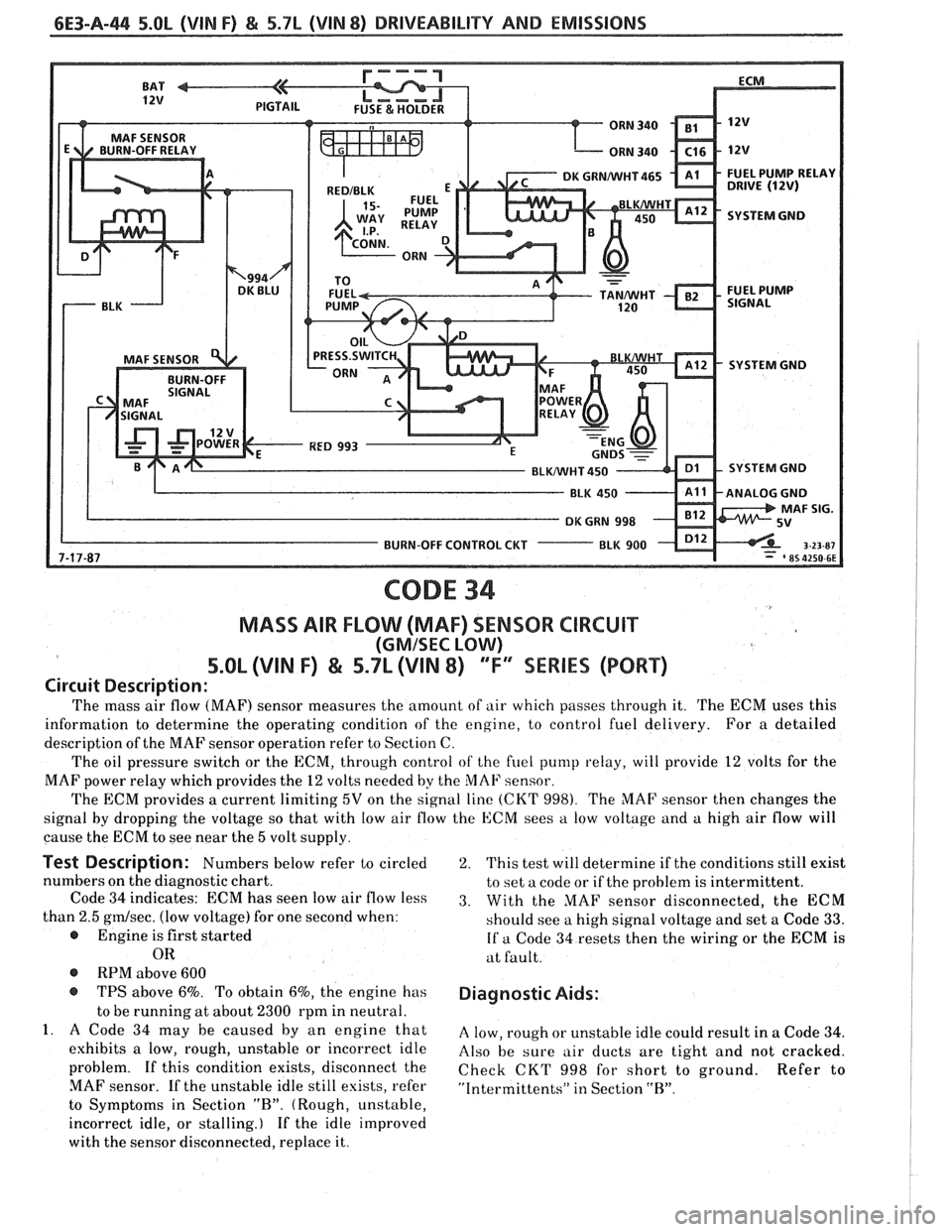
6E3-A-44 5.0b (VIN F) & 5.7L (VIN 8) DRIVEABILITY AND EMISSIONS
SYSTEM GND
SYSTEM GND
BLUNVHT 450 SYSTEM GND
BURN-OFF CONTROL CUT
CODE 34
MASS AIR FLOW (MAF) SENSOR CIRCUIT
(GMISEC LOW)
5.OL (VIN F) & 5.7L (\/IN 8) "F"" SERIES (PORT)
Circuit Description:
The mass air flow (MAF) sensor measures the amount of air which passes through it. The ECM uses this
information to determine the operating condition of the engine, to control fuel delivery. For a detailed
description of the MAF sensor operation refer to Section C.
The oil pressure switch or the ECM, through control
of the fuel pump relay, will provide 12 volts for the
MAF power relay which provides the
12 volts needed by the MAF sensor.
The ECM provides a current limiting
5V on the signal line (CKT 998). The MAF sensor then changes the
signal by dropping the voltage so that with low air flow the ECM sees
a low voltage and a high air flow will
cause the ECM to see near the
5 volt supply.
Test Description: Numbers below refer to circled
numbers on the diagnostic chart.
Code
34 indicates: ECM has seen low air flow less
than
2.5 gmlsec. (low voltage) for one second when:
@ Engine is first started
OR
@ RPM above 600
@ TPS above 6%. To obtain 6%, the engine has
to be running at about
2300 rpm in neutral.
1. A Code 34 may be caused by an engine that
exhibits a low, rough, unstable or incorrect idle
problem. If this condition exists, disconnect the
MAF sensor. If the unstable idle still esists, refer
to Symptoms in Section
"R". (Rough, unstable,
incorrect idle, or stalling.) If the idle improved
with the sensor disconnected, replace it.
2. This test will determine if the conditions still exist
to set a code or if the problem is intermittent.
3. With the MAF sensor disconnected, the ECM
should see a high signal voltage and set a Code
33.
If a Code 34 resets then the wiring or the ECM is
at fault.
Diagnostic Aids:
A low, rough or unstable idle could result in a Code 34.
Also be sure air ducts are tight and not cracked.
Check CKT
998 for short to ground. Refer to
"Intermittents" in Section "R".
Page 868 of 1825
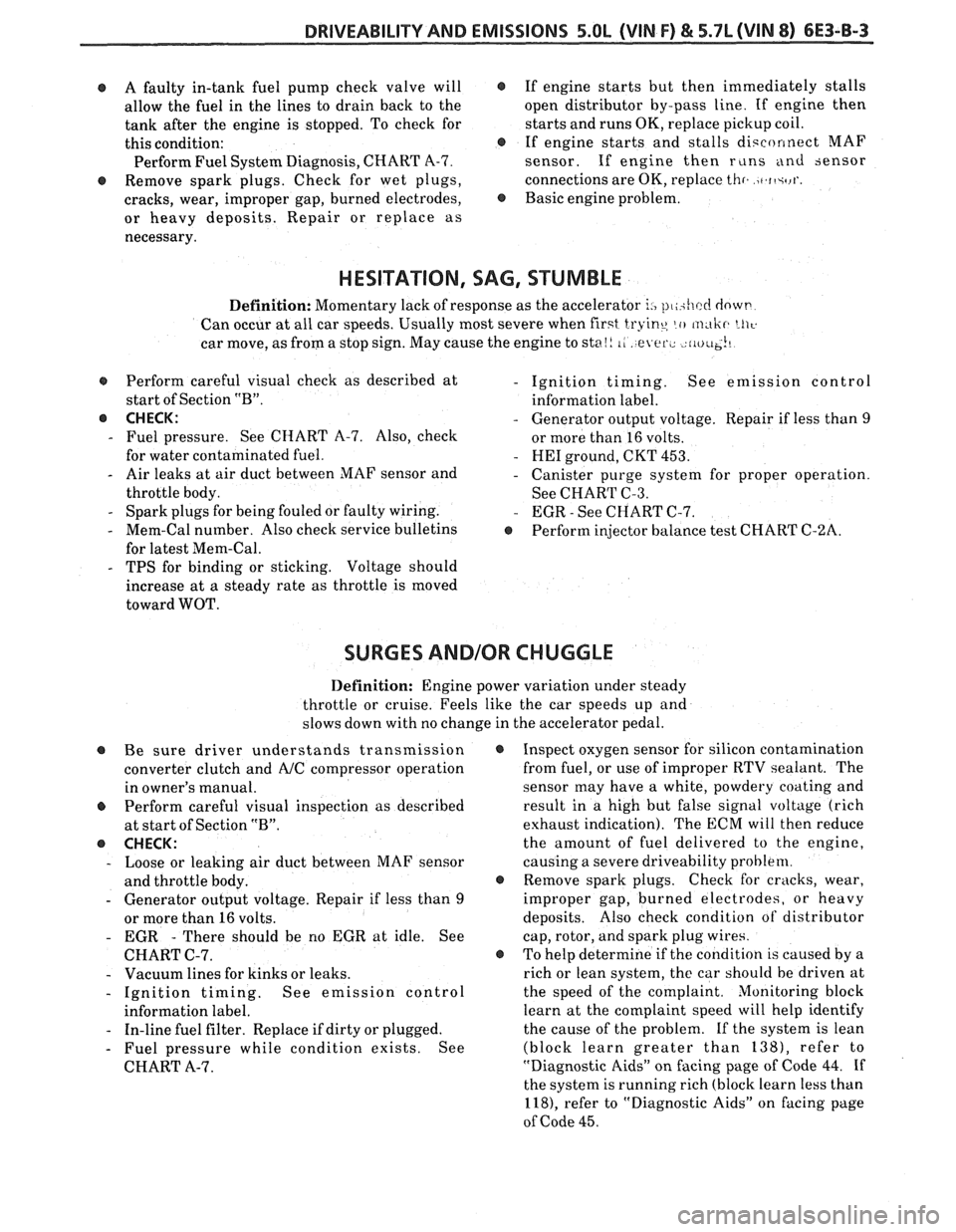
DRIVEABILITY AND EMISSIONS 5.OL (VIN F) & 5.7L (VIN 8) 6E3-8-3
@ A faulty in-tank fuel pump check valve will @
allow the fuel in the lines to drain back to the
tank after the engine is stopped. To check for
this condition:
e
Perform Fuel System Diagnosis, CHART A-7.
@ Remove spark plugs. Check for wet plugs,
cracks, wear, improper gap, burned electrodes,
@
or heavy deposits. Repair or replace as
necessary. If
engine starts but then immediately stalls
open distributor by-pass line. If engine then
starts and runs OK, replace pickup coil.
If engine starts and stalls disconnect MAF
sensor. If engine then
r~lns and sensor
connections are OK, replace
thr. )t.ft+rl'.
Basic engine problem.
HESITATION, SAG, STUMBLE
Definition: Momentary lack of response as the accelerator i., pl,ihcc! dowt-
Can occur at all car speeds. Usually most severe when first tryine, lo m,tlir. LII~.
car move, as from a stop sign. May cause the engine to sta!! 1, e er., riu~~~!~
s Perform careful visual check as described at
start of Section
"B".
@ CHECK:
- Fuel pressure. See CHART A-7. Also, check
for water contaminated fuel.
- Air leaks at air duct between MAF sensor and
throttle body.
- Spark plugs for being fouled or faulty wiring.
- Mem-Cal number. Also check service bulletins
for latest Mem-Cal.
- TPS for binding or sticking. Voltage should
increase at
a steady rate as throttle is moved
toward WOT.
- Ignition timing. See emission control
information label.
- Generator output voltage. Repair if less than 9
or more than 16 volts.
- HE1 ground, CKT 453.
- Canister purge system for proper operation.
See CHART C-3.
- EGR - See CHART C-7.
e Perform injector balance test CHART C-2A.
SURGES AND/OR CHUGGLE
Definition: Engine power variation under steady
throttle or cruise. Feels like the car speeds up and
slows down with no change in the accelerator pedal.
@ Be sure driver understands transmission
converter clutch and
AJC compressor operation
in owner's manual.
Perform careful visual inspection as described
at start of Section
"B".
e CHECK:
- Loose or leaking air duct between MAF sensor
and throttle body.
- Generator output voltage. Repair if less than 9
or more than 16 volts.
- EGR - There should be no EGR at idle. See
CHART C-7.
- Vacuum lines for kinks or leaks.
- Ignition timing. See emission control
information label.
- In-line fuel filter. Replace if dirty or plugged.
- Fuel pressure while condition exists. See
CHART A-7.
@ Inspect oxygen sensor for silicon contamination
from fuel, or use of improper RTV sealant. The
sensor may have a white, powdery coating and
result in a high but false signal voltage (rich
exhaust indication). The ECM will then reduce
the amount of fuel delivered to the engine,
causing a severe driveability problem.
@ Remove spark plugs. Check for cracks, wear,
improper gap, burned electrodes, or heavy
deposits. Also check condition of distributor
cap, rotor, and spark plug wires.
@ To help determine if the condition is caused by a
rich or lean system, the car should be driven at
the speed of the complaint. Monitoring block
learn at the complaint speed will help identify
the cause of the problem.
If the system is lean
(block learn greater than
1381, refer to
"Diagnostic Aids"
on facing page of Code 44. If
the system is running rich (block learn less than
1181, refer to "Diagnostic Aids" on facing page
of Code
45.
Page 869 of 1825

6E3-B-4 5.OL (VIN F) & 5.7L (VIN 8) DRIVEABILITY AND EMISSIONS
LACK OF POWER, SLUGGISH, OR SPONGY
Definition: Engine delivers less than expected power. Little or
no increase in speed when accelerator pedal is pushed down part way.
@ Perform careful visual check as described at
start of Section "B".
@ Compare customer's car to similar unit.
Make sure the customer's car has an actual
problem.
@ Remove air cleaner and check air filter for
dirt, or for being plugged. Replace as
necessary.
@ CHECK:
- For loose or leaking air duct between MAF
sensor and throttle body.
- Ignition timing. See emission control
information label.
- Restricted fuel filter, contaminated fuel or
improper fuel pressure. See CHART A-7.
- ECM Ground circuits - See ECM wiring
diagrams.
- EGR operation for being open, or partly open
all the time
- CHART C-7.
- Exhaust system for possible restriction: See
CHART
B-1.
- Inspect exhaust system for damaged or
collapsed pipes.
- Inspect muffler for heat distress or possible
internal failure.
- For possible plugged catalytic convertor by
comparing exhaust system backpressure on
each side at engine. Check backpressure by
removing
A.1.R check valves near exhaust
manifolds. See CHART
B-1 for procedure.
- Generator output voltage. Repair if less than 9
or more than 16 volts.
- Engine valve timing and compression.
- Engine for proper or worn camshaft. See Section
"6A".
- Secondary voltage using a shop ocilliscope or a
spark tester
5-26792 (ST-125) or equivalent.
- Check for excessive knock retard. See CHART
C-5.
DETONATION ISPARK KNOCK
Definition: A mild to severe ping, usually worse under
acceleration. The engine makes sharp metallic knocks that
change with throttle opening. Sounds like popcorn popping.
@ Check for obvious overheating problems:
- Low coolant.
- Loose water pump belt.
- Restricted air flow to radiator, or restricted
water flow thru radiator.
- Inoperative electric cooling fan circuit. See
CHART C-12.
@ CHECK:
- Ignition timing. See vehicle emission control
information label.
- EGR system for not opening - CHART C-7.
- TCC operation - CHART C-8.
- Fuel system pressure. See CHART A-7.
- Mem-Cal - Be sure it's the correct one. (See
"Service Bulletins").
- Valve oil seals for leaking.
@ Check for incorrect basic engine parts such as
cam, heads, pistons, etc.
@ Checkforpoorfuelquality.
@ Remove carbon with top engine cleaner. Follow
instructions on can.
@ Check ESC system
See CHART C-5
@ To help determine if the condition is caused by a
rich or lean system, the car should be driven at
the speed of the complaint. Monitoring block
learn at the complaint speed will help identify the
cause of the
problem. If the system is runnig lean
(block learn greater than
1381, refer to
"Diagnostic Aids" on facing page of Code
44. If
the system is running rich (block learn less than
1181, refer to "Diagnostic Aids" on facing page of
Code 45.
Page 870 of 1825
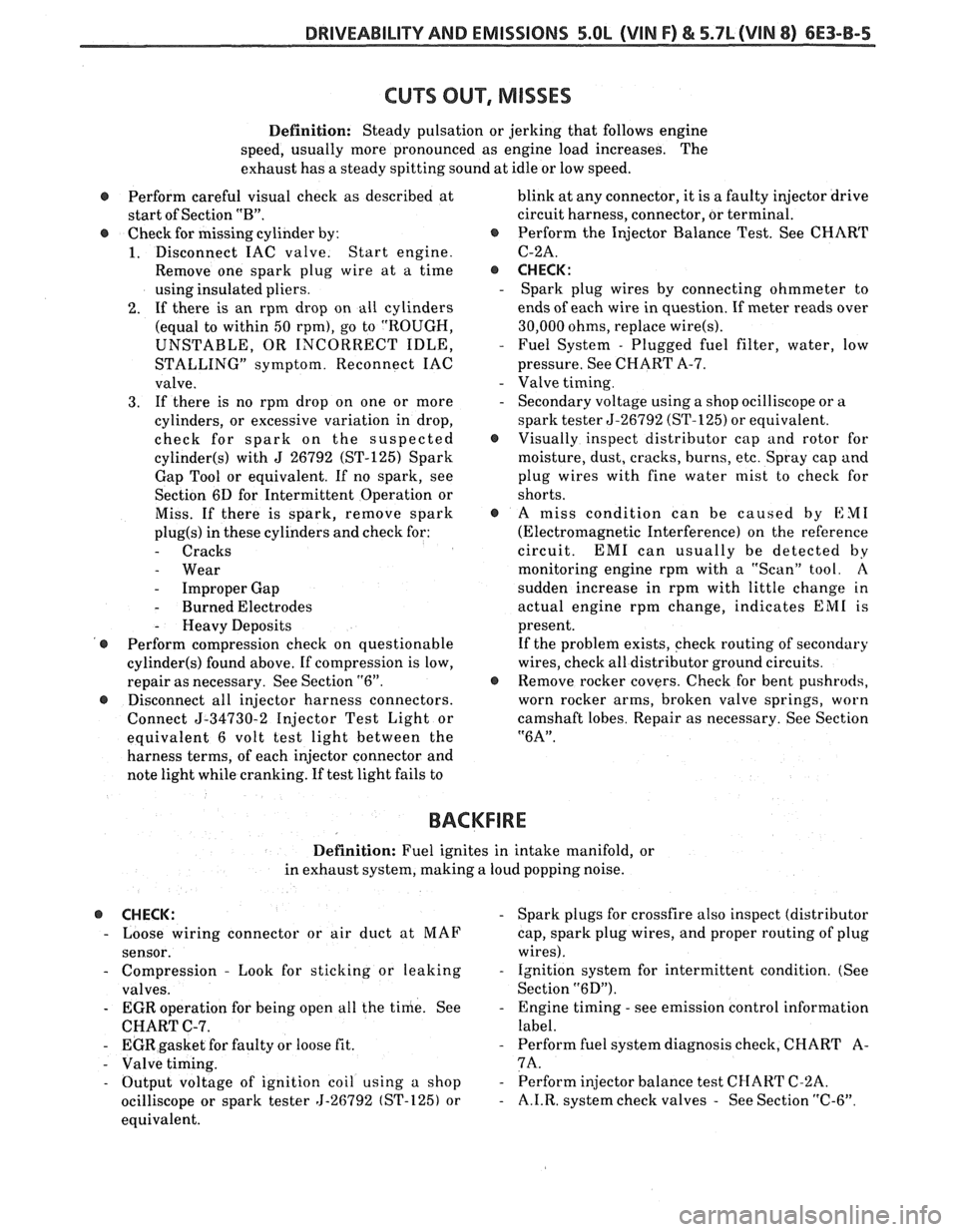
DRIVEABILITY AND EMISSIONS S.OL (VIN F) & 5.7L (VIN 8) 6E3-B-5
Definition: Steady pulsation or jerking that follows engine
speed, usually more pronounced as engine load increases. The
exhaust has
a steady spitting sound at idle or low speed.
@ Perform careful visual check as described at blink
at any connector, it is a faulty injector drive
start of Section
"B". circuit harness, connector, or terminal.
@ Check for missing cylinder by: @ Perform the Injector Balance Test. See CHART
1. Disconnect IAC valve. Start engine. C-2A.
Remove one spark plug wire at a time
@ CHECK:
using insulated pliers. - Spark plug wires by connecting ohmmeter to
2. If there is an rpm drop on all cylinders ends
of each wire in question. If meter reads over
(equal to within
50 rpm), go to "ROUGH, 30,000
ohms, replace wire(s).
UNSTABLE, OR INCORRECT IDLE, - Fuel System - Plugged fuel filter, water, low
STALLING" symptom. Reconnect IAC pressure. See CHART A-7.
valve.
- Valve timing.
3. If there is no rpm drop on one or more - Secondary voltage using a shop ocilliscope or a
cylinders, or excessive variation in drop, spark tester 5-26792 (ST-125)
or equivalent.
check for spark on the suspected
@ Visually inspect distributor cap and rotor for
cylinder(s) with J 26792 (ST-125) Spark moisture, dust, cracks, burns, etc. Spray cap and
Gap Tool or equivalent. If no spark, see plug wires with fine water mist to check for
Section 6D for Intermittent Operation or shorts.
Miss. If there is spark, remove spark
@ A miss condition can be caused by EM1
plug(s) in these cylinders and check for: (Electromagnetic Interference) on the reference
- Cracks circuit. EM1 can usually be detected by
- Wear monitoring engine rpm with a "Scan" tool. A
- Improper Gap sudden
increase in rpm with little change in
- Burned Electrodes actual engine rpm change, indicates EM1 is
- Heavy Deposits present.
@ Perform compression check on questionable If
the problem exists, check routing of secondary
cylinder(s) found above. If compression is low, wires, check
all distributor ground circuits.
repair as necessary. See Section
"6". @ Remove rocker covers. Check for bent pushrods,
@ Disconnect all injector harness connectors. worn
rocker arms, broken valve springs, worn
Connect
5-34730-2 Injector Test Light or camshaft
lobes. Repair as necessary. See Section
equivalent 6 volt test light between the
"6A".
harness terms, of each injector connector and
note light while cranking. If test light fails to
BACKFIRE
Definition: Fuel ignites in intake manifold, or
in exhaust system, making a loud popping noise.
@ CHECK: - Spark plugs for crossfire also inspect (distributor
- Loose wiring connector or air duct at MAF
cap, spark plug wires, and proper routing of plug
sensor. wires).
- Compression - Look for sticking or leaking - Ignition system for intermittent condition. (See
valves. Section
"6D").
- EGR operation for being open all the time. See - Engine timing - see emission control information
CHART C-7. label.
- EGR gasket for faulty or loose fit. - Perform fuel system diagnosis check, CHART A-
- Valve timing. 7A.
- Output voltage of ignition coil using a shop - Perform injector balance test CI-IART C-2A.
ocilliscope or spark tester 5-26792 (ST-125) or
- A.I.R. system check valves - See Section "C-6".
equivalent.
Page 888 of 1825

DRIVEABILITY AND EMISSIONS 5.OL (VIN F) & 5.7L (VIN 8) 6E3-C2-1
SECTION C2
FUEL CONTROL SYSEENI
CONTENTS
GENERAL DESCRIPTION . . . . . . . . . . . . . . . . C2-1
PURPOSE ........................ C2-1
MODES OF OPERATION . . . . . . . . . . . . . . C2-2
Starting Mode . . . . . . . . . . . . . . . . . . . C2-2
Clear Flood Mode.. . . . . . . . . . . . . . . . C2-2
Run Mode.. . . . . . . . . . . . . . . . . . . . . . C2-2
Acceleration Mode.. . . . . . . . . . . . . . . C2-2
Deceleration Mode . . . . . . . . . . . . . . . C2-3
Battery Voltage Correction Mode . . . . . C2-3
Fuel Cutoff Mode . , . . . . . . . . . . . . . . . C2-3
FUEL CONTROL SYSTEM . . . . . . . . . . . . . . C2-3
Basic System Operation . . . . . . . . . . . . C2-3
Throttle Body Unit . . . . . . . . . . . . . . . . C2-3
Fuel Rail . . . . . . . . . . . . . . . . . . . . . . . C2-3
Fuel Injectors . . . . . . . . . . . . . . . . . . . . C2-3
Pressure Regulator . . . . . . . . . . . . . . . C2-4
IAC Valve . . . . . . . . . . . . . . . . . . . . . . . C2-4
Fuel Pump Electrical Circuit . . . . . . . . , C2-5
DIAGNOSIS
......................... C2-5
FUEL CONTROL SYSTEM . . . . . . . . . . . . . . C2-5
IDLE AIR CONTROL VALVE . . . .. 0.. . a. C2-5
FUEL SYSTEM PRESSURE TEST . .. . . . . . . C2-5
ON-CAR SERVICE
. . . . . . . . . . . . . . . . . . . . . C2-5
PORT FUEL INJECTION COMPONENTS . . . . C2-5
FUEL PRESSURE RELIEF PROCEDURE . . . . . C2-5
Plenum ........................ C2-5
FUEL RAlL ASSEMBLY . . . . . . . . . . . . . . . . C2-6
FUEL
RAlL SERVICE . . . . . . . . . . . . . . . . . . . C2-7
IDENTIFICATION . . . . . . . . . . . . . . . . . . . C2-7
UNlT SERVICE PROCEDURES .. . . . . . . . .. C2-7
COLD START TUBE & VALVE ASSEMBLY.. . C2-7
PARTS INFORMATION
. . . . . . . . . . . . . . . C2-9
FUEL PRESSURE CONNECTION ASSY. . . . . C2-10
FUEL INJECTORS (Rail Removed) . . . . . . . . C2-10
PRESSURE REGULATOR (Rail Removed) . . . C2-10
COLD START FUEL INJECTION SWITCH . . . C2-11
THROTTLEBODY ................... C2-11
THROTTLE BODY SERVICE IDENTIFICATION
. C2-12
UNlT REPAIR PROCEDURES . . . . . . . . . . . . C2-12
TPS Adjustment .............. C2-12
MINIMUM IDLE SPEED CHECK . . . . . . . . . . . C2-12
PARTSINFORMATION ................. C2-15
IDLE AIR C'NT' L VALVE ASSY & GASKET . . C2-15
CLEAN AIR COVER &GASKET . . . . . . . . . . C2-15
IDLE AIR CONTROUCOOLANT CVR. ASSY . C2-15
Throttle Body Removed From Engine . . C2-15
FUEL PUMP RELAY . . . . . . . . . . . . . .,. . . . C2-16
OIL PRESSURE SWITCH . . . . . . . . . . . . . . . C2-16
PARTS INFORMATION . . . . . . . . . . . . . . . . . C2-16
GENERAL DESCRIPTION
PURPOSE
The basic function of the fuel control system is to
control fuel delivery to the engine.
Fuel is delivered to the engine by individual fuel
injectors mounted in the intake manifold near each
cylinder.
The main control sensor is the oxygen
(02) sensor,
which is located in the exhaust manifold. The
O2
sensor tells the electronic control module (ECM) how
much oxygen is in the exhaust gas.
The ECM changes
the
airlfuel ratio to the engine by controlling the fuel
injectors.
The best mixture to minimize exhaust
emissions is
14.7 to 1, which allows the catalytic
converter to operate the most efficiently. Because of
the constant measuring and adjusting of the
airlfuel
ratio, the fuel injection system is called a "Closed
Loop" system (shown in Figure
C2-I).
EXHAUST OXYGEN 02 SENSOR
CATALYTIC CONVERTER
Figure C2-1 "Closed Loop" System
Page 890 of 1825
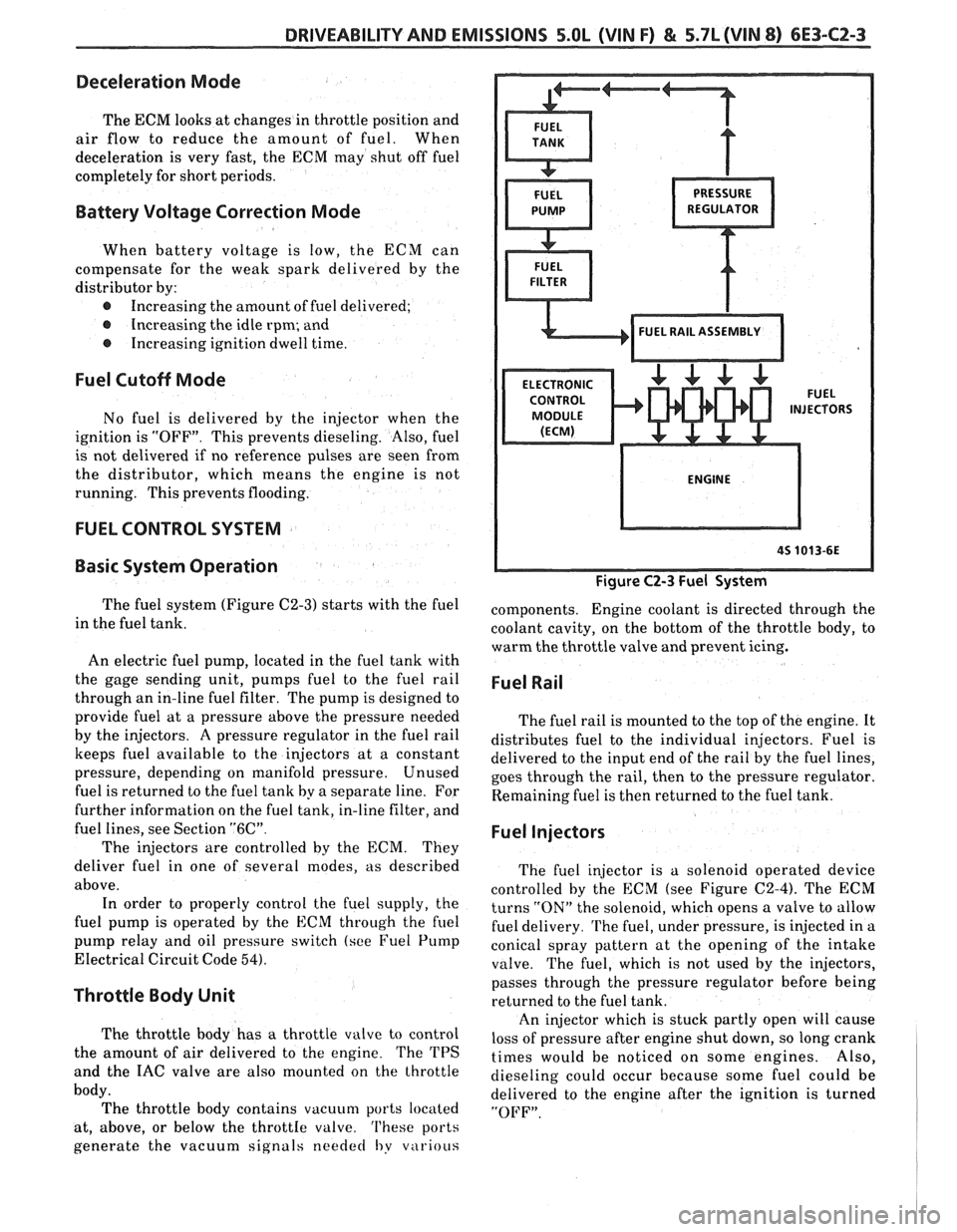
DRIVEABILITY AND EMISSIONS 5.OL (VIN F) & 5.7L (VIN 8) 6E3-CZ-3
Deceleration Mode
The ECM looks at changes in throttle position and
air flow to reduce the amount of fuel. When
deceleration is very fast, the ECM may shut off fuel
completely for short periods.
Battery Voltage Correction Mode
When battery voltage is low, the ECM can
compensate for the weak spark delivered by the
distributor by:
@ Increasing the amount of fuel delivered;
@ Increasing the idle rpm; and
@ Increasing ignition dwell time.
Fuel Cutoff Mode
No fuel is delivered by the injector when the
ignition is "OFF". This prevents dieseling. Also, fuel
is not delivered if no reference pulses are seen from
the distributor, which means the engine is not
running. This prevents flooding.
FUEL CONTROL SYSTEM
Basic System Operation
The fuel system (Figure C2-3) starts with the fuel
in the fuel tank.
An electric fuel pump, located in the fuel tank with
the gage sending unit, pumps
fuel to the fuel rail
through an in-line fuel filter. The pump is designed to
provide fuel at a pressure above the pressure needed
by the injectors. A pressure regulator in the fuel rail
keeps fuel available to the injectors at
a constant
pressure, depending on manifold pressure. Unused
fuel is returned to the fuel tank by a separate line. For
further information on the fuel tank, in-line filter, and
fuel lines, see Section
"6C".
The injectors are controlled by the ECM. They
deliver fuel in one of several modes, as described
above. In order to properly control the fuel supply, the
fuel pump is operated by the
ECM through the fuel
pump relay and oil pressure switch (see Fuel Pump
Electrical Circuit Code
54).
Throttle Body Unit
The throttle body has a throttle valve to control
the amount of air delivered to the engine. The TPS
and the IAC valve are also mounted on the throttle
body. The throttle body contains vacuum ports located
at, above, or below the
throttIe valve. 'I'hese ports
generate the vacuum signals
needed I,y v~irious
Figure C2-3 Fuel System
components. Engine coolant is directed through the
coolant cavity, on the bottom of the throttle body, to
warm the throttle valve and prevent icing.
Fuel Rail
The fuel rail is mounted to the top of the engine. It
distributes fuel to the individual injectors. Fuel is
delivered to the input end of the rail by the fuel lines,
goes through the rail, then to the pressure regulator.
Remaining fuel is then returned to the fuel tank.
Fuel Injectors
The fuel injector is a solenoid operated device
controlled by the ECM (see Figure
C2-4). The ECM
turns
"ON" the solenoid, which opens a valve to allow
fuel delivery.
The fuel, under pressure, is injected in a
conical spray pattern at the opening of the intake
valve. The fuel, which is not used by the injectors,
passes through the pressure regulator before being
returned to the fuel tank.
An injector which is stuck partly open will cause
loss of pressure after engine shut down, so long crank
times would be noticed on some engines. Also,
dieseling could occur because some fuel could be
delivered to the engine after the ignition is turned
"OFF".